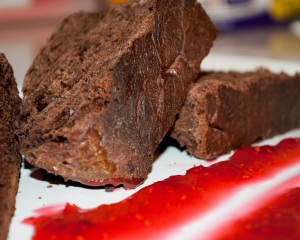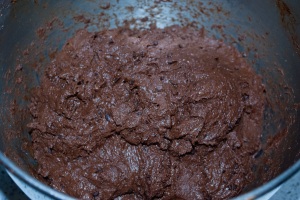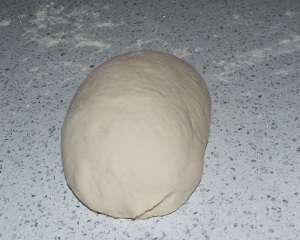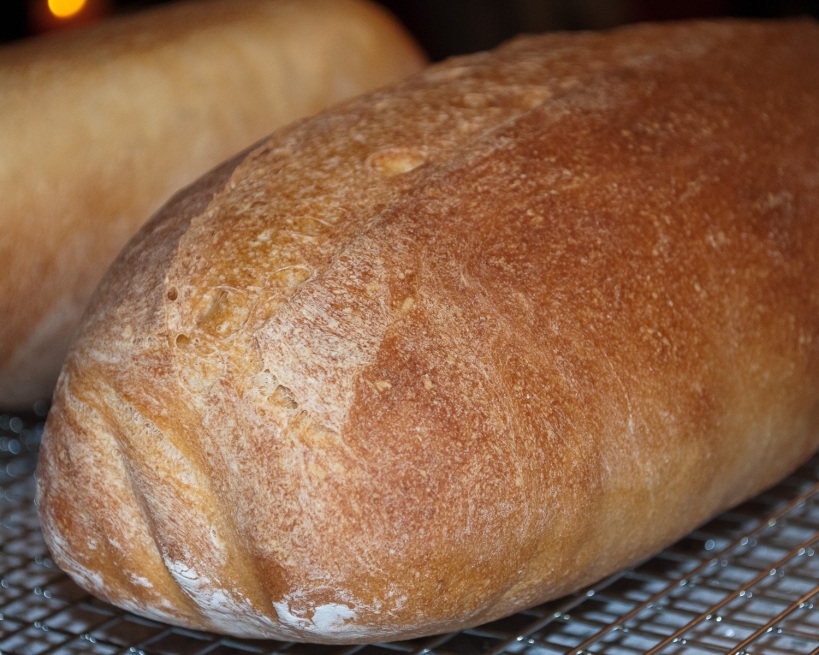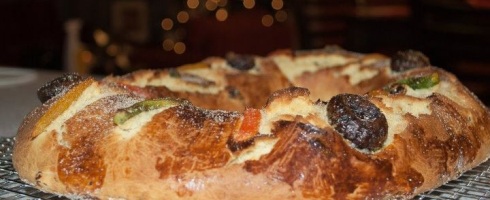With Valentines Day just a day away, forget about buying chocolates for your significant other! Make something for them!!! This weeks inspiration comes from a deep, dark part of my heart. My chocolate heart that is!
My mother bought me a book for my birthday, Artisan Bread in Five Minutes a Day by Jeff Hertzberg and Zoe Francois, and leafing through the pages my eyes immediately locked upon a recipe for chocolate bread. As I began to read the details about making this bread, I could not help but think what an addition chile would be to this recipe! Chocolate and chiles are such a flavor affinity to me! So, once the weekend came, it was time to itch my baking scratch! You will notice the recipe is by volume rather than by weight. This is a bit inconsistent in my opinion, but I did not take the time to convert and test the recipe by weight. I was too anxious to eat this creation!
The instructions called to place the yeast, water, honey, and salt in a container first, then add the dry ingredients. Having a little bit of bread making under my belt by now, I decided to alter this and I proofed the yeast in about a ½ cup of warm water (about 105°F) with a teaspoon of honey. While the yeast was activating, I set to making the ganache. I used a double boiler and combined the butter and the chocolate. Once the chocolate and butter were completely melted, I added the ancho chile powder and the cayenne pepper and whisked to incorporate. I set the ganache aside to cool a bit. Once it was cool, I then mixed all the wet ingredients together, added them to the dry ingredients and I mixed this in my Kitchen Aid mixer for about 2 minutes. I let the dough rest, covered, for about 20 minutes, and finally added the salt and mixed again for about 2 more minutes (autolyse!). I then let the dough proof for about 2 hours. After the initial proof, the dough is ready to be formed, so I divided it in 2 equal portions of approximately 1.5 lbs. each and formed each into a boule. You will notice that this dough is quite sitcky and difficult to work with, I believe that this is due to the fact that the dough is made to be used over the course of a week, from your refrigerator (which makes it easier to handle). In order to form this dough correctly, use a liberal amount of flour on your work surface and dust the dough with a good handful of flour as your forming your boule. Let the boules rise once again for about 1 hour, then pop them in your oven for about 30 minutes. While the bread is in the oven, you can set about making the preserves!
The raspberry preserves are an astonishingly simple and delicious addition to this bread. Simply bring your raspberries to a quick boil for about 1 minute, mash them up with a potato masher, then add your sugar. These preserves require no pectin whatsoever. I like this recipe because using pectin requires adding more sugar, which dilutes the natural flavor of the fruit. The raspberries have enough natural pectin to do the trick. Just continue to cook the raspberries for about 5 minutes, stirring almost constantly. Then just ladle the mixture into your prepared canning jars. As the mixture cools it will form that gel that you are looking for.
Take the chocolate bread and spread a nice size dollop of raspberry jelly on a slice. I just love the deep bittersweet flavor of the chocolate and the subtle notes of sweetness in the honey, then the biting finish of the chile. The sweet raspberry preserves are a wonderful counterpoint to the bittersweet chocolate. Forget heaven, chocolate and chiles are a match made for my kitchen!
Chocolate and Chile Ancho Bread
( Adapted from The Artisan Bread in Five Minutes a Day )
- 4 ounces bittersweet chocolate (I used Ghirardelli 60% Cacao)
- 1 tablespoon Ancho Chile powder
- 1/8 teaspoon Cayenne Pepper
- ½ cup unsalted butter (1 stick)
- 1 ¾ cup lukewarm water (100°-105°F)
- 1 ½ tablespoons active dry yeast
- 1 ½ tablespoons kosher salt
- 4 large eggs, lightly beaten
- 1 large egg for the egg wash
- 2/3 cup honey
- 5 ½ cups unbleached all-purpose flour
- 1 cup unsweetened cocoa powder (I used Ghirardelli )
- 5 ounces finely chopped bittersweet chocolate (Ghirardelli 60% Cacao)
- Proof the yeast by taking it and mixing it with about ½ cup of the warm water and 1 teaspoon of the honey in a cup or a bowl. Allow it to sit in a warm place. Once it doubles in volume it is ready to use.
- While the yeast is proofing, make the ganache by melting the butter and the 4 ounces of chocolate in a double boiler. Once they are melted , add the chile powder and the cayenne pepper mixture and blend well with a whisk. Set aside to cool.
- Take the 5 ounces of chocolate and pulse until finely chopped in a food processor.
- Mix the proofed yeast, the rest of the water, and the honey with the eggs in your mixing bowl.
- Add the flour, the chopped chocolate, the ganache, and the cocoa powder and mix for 2 minutes using the dough hook attachment.
- Cover and allow to rest for 20 minutes.
- After 20 minutes, add the salt and mix once again for 2 minutes using the dough hook.
- Cover and allow to proof for about 2 hours.
- Dust your work surface liberally with flour then take the dough from the mixing bowl. Dust dough liberally with flour and divide into 2 1 ½ lb. portions.
- Work each into a boule by stretching the surface of the dough around to the bottom, turning the dough in quarter turns as you go.
- Place on parchment paper and let the boules rise for 1 hour.
- Preheat your oven with the baking tiles or baking stones to 350F. Allow a minimum of 30 miuntes for the tiles to come to temperature.
- Simply take one egg and whisk it and then brush the surface of each boule with the egg wash.
- Slash the boules in a cross pattern, a tic-tac-toe pattern, or 3 vertical slashes.
- Bake the boules in the oven for about 15 minutes, then rotate to ensure even baking.
- Bake for a final 15-20 minutes.
- Allow to cool completely on a wire rack. You can try and dust the boule with some powdered sugar if you want. I tried it on one boule!
Fresh Raspberry Preserves
- 4 cups raspberries
- 4 cups sugar
- Bring the raspberries to a hard boil in a saucepan over medium-high heat. Boil for 1 minute
- Add the sugar and bring to a boil once again.
- Cook for 5 minutes, stirring almost constantly.
- Remove from heat and ladle into prepared canning jars or if you plan on using it right away, just some airtight sterilized glass containers!


